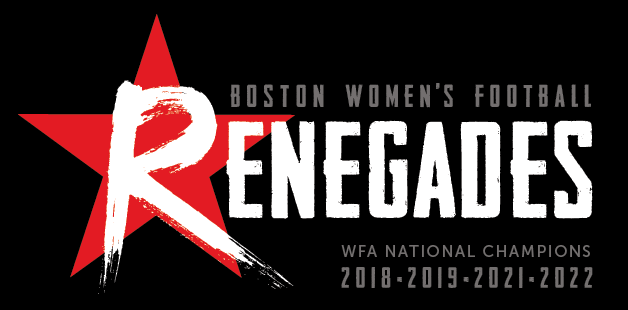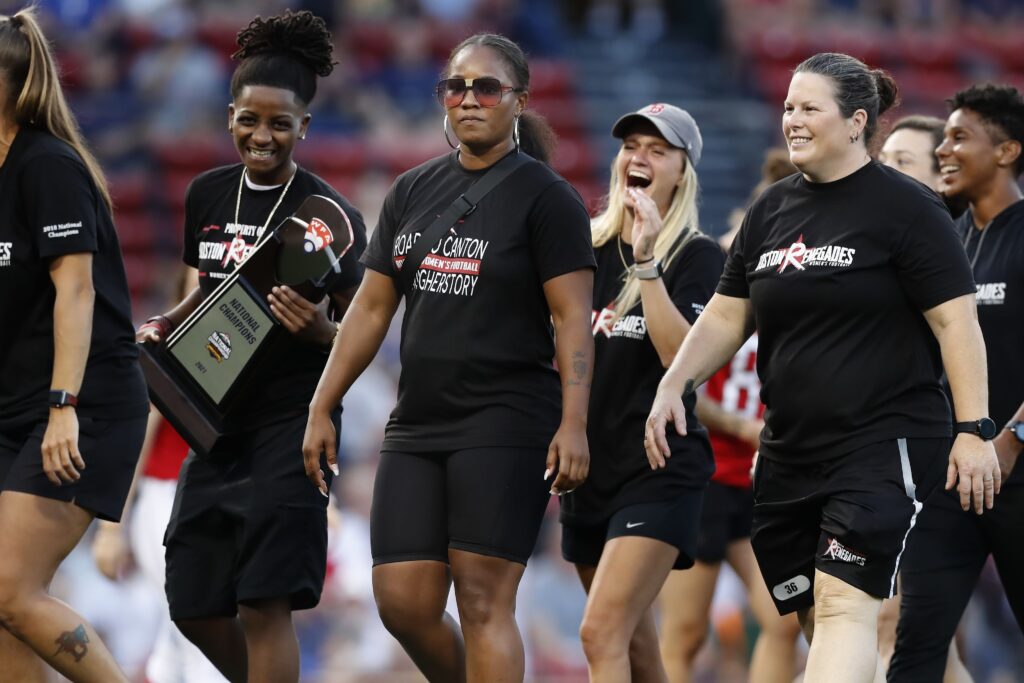The long history of women’s football in the U.S. almost certainly will surprise you
By Frankie de la Cretaz | Washington Post
There is a football dynasty taking shape — but you probably haven’t heard of it. The Boston Renegades of the Women’s Football Alliance have won three championships in a row (in 2018, 2019 and 2021; the 2020 season was canceled because of covid-19), and regularly beat opponents by more than 50 points. Their 2021 championship was the sixth in franchise history — matching their NFL counterpart, the New England Patriots.
But few sports fans know of these achievements. The average game at Harry della Russo Stadium in Revere, Mass., just north of Boston, draws about 500 fans.
This is not surprising. In fact, a similar thing happened 50 years ago with the winningest team in pro football history: the Toledo Troopers. While their exact record is disputed, they went somewhere around 64-5 over nine seasons in the National Women’s Football League, from 1971-1979. Linda Jefferson, their star halfback, retired with 140 touchdowns, more than Pro Football Hall of Famers O.J. Simpson, Walter Payton and Jim Brown. And yet, they too went under the radar.
Why? Because American football’s reputation as a men’s sport — and perhaps the most masculine-coded sport of them all — affects how seriously the women’s game is taken. Particularly in the case of football, women athletes have broken social norms and been dismissed, trivialized or erased completely for doing so.
Women have been playing football since its inception in the late 1800s. Time and again, however, women were only allowed to play the sport as a sideshow for gawking male spectators. For example, in 1896, women scrimmaged one another in New York City as an entertainment show before a men’s social ball. But the onlookers were shocked when the women began to play and the game became rough, with the women taking out the entire front row of spectators at one point. Eventually, the police stepped in to break it up before any of the players were injured.
A similar thing happened in 1926, when the Frankford Lady Yellow Jackets took the field as the halftime entertainment for an NFL game. They were expected to play a couple of men in a brief scrimmage, much in the same way a court jester is trotted out in front of a crowd of royals for a laugh. Newspaper coverage of the NFL game made brief mention of the Lady Yellow Jackets “cavorting” but failed to mention any plays they ran, ultimately dismissing the halftime amusement as “particularly dead.”
When girls football teams popped up in places like South Dakota, they were forced to stop playing because of complaints from other schools. In the early 1930s, two teams in Ohio played exhibition games against each other until first lady Lou Henry Hoover complained that the men who ran the teams were “exploiting womanhood.” This was surprising, because Hoover had joined the women’s division of the National Amateur Athletic Federation in 1923 and preached the importance of “a sport for every girl, and every girl in sport.”
But women playing football challenged gender norms at a time when concerns for the health and reproductive ability of women reigned. And the game’s physicality and violence seemed to threaten those paramount concerns.
Yet women still wanted to play football, and they kept up their demand for legitimacy.
In 1967, Cleveland promoter Sid Friedman started a women’s football troupe as a farce and a way to make a quick buck. But he, too, was surprised when the women who showed up to play didn’t want to make a spectacle of themselves in skimpy outfits. They came to play football.
Friedman was eventually cut out of the growing league, in part, because these women took themselves far more seriously than he ever would. He suggested the Troopers throw games because they were too dominant and sent a photographer from Hustler to another team’s practice. “He wanted the carnival,” Columbus Pacesetters player Linda Stamps said. “He wanted us to turn football into faux wrestling, and we said no.”
And so they found owners who believed in them and wanted to help them develop into legitimate athletes on the gridiron. Bill Stout, a former All-City nose guard for DeVilbiss High School in Toledo whose pro football dreams had crumbled, was the head coach of the Toledo Troopers. He rigorously trained his team and would be one of the first men to go to bat for his players and help them create and envision a league deserving of their skill. So did Robert “Bob” Mathews. An electrical contractor and aspiring businessman, Mathews started the Los Angeles Dandelions and organized a meeting to bring this ragtag collection of independent outlets together.
By 1974, the teams had branched out on their own to form the NWFL. They were buoyed by the ongoing women’s liberation movement and the recent passage of Title IX, which opened up many new athletic opportunities for women.
The league faced many challenges. They weren’t taken seriously by the press. Reporters only seemed interested in asking whether they were “women’s libbers” or what their (presumed) male partners thought about the women playing such a rough sport. Women were asked about how they kept their weight down, and many of the male sportswriters took every opportunity to insult the play, sometimes asking women if they even knew how to call a play.
Fans came to games out of curiosity but often never returned. As a result, attendance — and media coverage — dwindled as seasons went on.
One major problem: The on-field product couldn’t compete with men’s football because the women had no youth football pipeline to learn the game and often had to pick it up as adults. Many of the women were self-identified tomboys or had spent their lives playing sports. Some were collegiate softball players, others played club sports through their local lesbian bars. But in a time before Title IX, they had no access to organized sports.
While the women picked up the game quickly, the male investors who owned the teams often gave up after a few seasons when they failed to turn a profit. By 1980, most of the original NWFL teams had folded. But the women of the NWFL found new revenue sources, funding their teams through carwashes and raffle tickets, selling ad space in their programs and concessions at games. Many chipped in their own money to keep their teams afloat, and most never saw the $25 paycheck they were promised for each game.
The NWFL played its last game in 1988, after teams had stopped developing organically, in part because a conservative political environment lamented, rather than celebrated, women bucking the system and challenging gender norms.
Women’s full-contact football went into a deep freeze until the late 1990s, when new leagues began to form. Those leagues of the late-’90s tie directly back to the NWFL. Not only did many of the teams look to the original league as an example, but a former Trooper had a hand in bringing women’s football back to Toledo. Mitchi Collette brought her experience playing for the championship Troopers when she started the Toledo Reign.
Today, there are roughly four semiprofessional women’s leagues in the United States, and players on these teams face similar challenges — notably a lack of financial support and media attention. But once again, women are innovating. They’re live-streaming their games on Facebook. They’re financing themselves the same way their predecessors did: through merchandise sales, raffle tickets and community sponsorships. Players in the leagues of yesteryear, and the ones today, are still working full-time jobs while training on the side, and shelling out their own money to pursue their dream.
Can we learn from the past to do better by the women playing today, and the ones who will take the field tomorrow? That hope might be possible soon, as women’s sports are gaining more public respect and better financing, especially in leagues such as the WNBA. Can we recognize a dynasty in the present, rather than just reflecting on it in the past? The Renegades sure hope so.
On July 24, after the team won the WFA championship game against the Minnesota Vixen, the crowd broke into a chant: “Dynasty! Dynasty!” The players, raising helmets, arms and fists in celebration, joined in.

